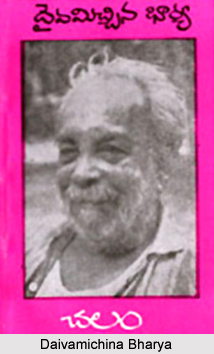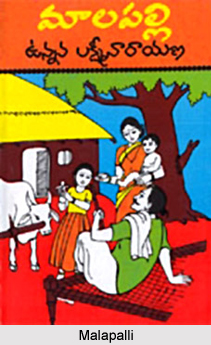 Telugu Novel in twentieth century has passed through a number of stages in the course of its development. In all these different phases, significant advancements were made in the various themes, form and technique of novel writing which contributed immensely to the development of this literary genre. The various important phases which shaped the development of the Telugu Novel in the Twentieth Century are discussed below.
Telugu Novel in twentieth century has passed through a number of stages in the course of its development. In all these different phases, significant advancements were made in the various themes, form and technique of novel writing which contributed immensely to the development of this literary genre. The various important phases which shaped the development of the Telugu Novel in the Twentieth Century are discussed below.
Telugu Novel in Early Twentieth Century
In the early part of the twentieth century a number of publishing houses came into existence which gave tremendous support to the growth of the novel. Saraswathi Granthamala (1898), Vignanachandrika Granthamala (1903), Andhra Pracharini Granthamala (1911), and Veguchukka Granthamala (1911) were, to a large extent, responsible for the consolidation of narrative tradition in Telugu. The spread of English education brought Telugu youth into contact with nineteenth-century novelists like Scott and Goldsmith. More importantly, the novel in Bengal had already grown into a powerful literary form and began playing a vital role in the cultural revival, and this had a definite impact on the developments of the Telugu novel in its formative phase. There were a number of translations of Bengali novels at this time including the works of Bankim Chandra Chatterjee, Sarat Chandra Chatterjee and Rabindranath Tagore. In this early phase, though the range of the novels widened considerably in terms of its themes, little technical advance was made. A number of social and historical novels were written during this phase, with more historical than social novels being written. Some of the works of this time include as Matru Mandiram (1920) by Venkata Parvateesa Kavulu and Chilakamarti`s Ganapathi (1920), Vishnuvardhanudu (1927) etc.
Telugu Novel from the 1920-1950
This period was marked by a lot of cultural conflict, frenzied political activity and rapid social changes. In dealing with these social changes novel-writing in Telugu literature developed to a great extent. This phase produced major novelists and their masterpieces. Many different kinds of narrative discourses developed during this time, and among the two major trends are - (1) a discourse of critical realism that calls into question not only the dominant imperial authority but all forms of authoritarian systems, including feudalism, caste system, class structure, and patriarchal ideology, and (2) fictionalizing the traditional ethos of a vanishing past and exploiting the textual space for the conservation of cultural values. Among the major novels produced during this period are Unnava Lakshminarayana`s Malapalli (1922), Gudipati Venkata Chalann`s Daivamichina Bharya (1923), Maidanam (1927), Viswanatha Satyanarayana`s Veyi Padagalu etc.
Telugu Novel in the post 1950`s period
 During this time Telugu novel was characterized by the search for form and experimental constructs. The Telugu novel enters the age of experimentation in the 1950s because the writers have, by this time, come under the influence of some of the important intellectual and ideological developments of the time, such as Freudian psychoanalysis, Marxian socialism, and European existentialism. Besides, the modernist writings of the West, too, have had considerable impact on the creative minds of the time. Furthermore, the writers of the 1950s, coming after the literary giants like Unnava and Viswanatha, needed to do something different and original in order to emerge out of the shadows of their predecessors. The psychological novel, probing the inner conflicts and complexes of the human psyche, found favour with a number of writers of this time. Some of the important works of this time include Gopichand`s Asmardhuni Jeevayatra (1960), Buchi Babu`s (S. Venkata Subba Rao) Chivamku Migiledi (1946), Rachakonda Viswanatha Sastry`s (Ravisastry) Alpajivi (1981) etc. Political satire was also an important element of the literature produced during this period. Works along this line include Kodavatiganti Kutumba Rao`s Chaduvu (1952), Ravisastry`s Govulostunnai Jagrata and Palagummi Padmaraju`s Bathikina College. The more overtly political novel, fielding specific political issues, is yet another significant development of this period.
During this time Telugu novel was characterized by the search for form and experimental constructs. The Telugu novel enters the age of experimentation in the 1950s because the writers have, by this time, come under the influence of some of the important intellectual and ideological developments of the time, such as Freudian psychoanalysis, Marxian socialism, and European existentialism. Besides, the modernist writings of the West, too, have had considerable impact on the creative minds of the time. Furthermore, the writers of the 1950s, coming after the literary giants like Unnava and Viswanatha, needed to do something different and original in order to emerge out of the shadows of their predecessors. The psychological novel, probing the inner conflicts and complexes of the human psyche, found favour with a number of writers of this time. Some of the important works of this time include Gopichand`s Asmardhuni Jeevayatra (1960), Buchi Babu`s (S. Venkata Subba Rao) Chivamku Migiledi (1946), Rachakonda Viswanatha Sastry`s (Ravisastry) Alpajivi (1981) etc. Political satire was also an important element of the literature produced during this period. Works along this line include Kodavatiganti Kutumba Rao`s Chaduvu (1952), Ravisastry`s Govulostunnai Jagrata and Palagummi Padmaraju`s Bathikina College. The more overtly political novel, fielding specific political issues, is yet another significant development of this period.
Women Writers of Telugu Novels
A notable feature of the Telugu novel is that this genre has encouraged many women writers. Women`s writing, in fact, forms a distinct and considerable segment. Writers like Jayanti Suramma, Suram Subhadramma and Kanaparthi Varalakshmamma were among the earliest to have used the fictional mode to project women`s issues. Between 1960 and 1980, a number of women writers took to the novel form and achieved considerable success through successive periodical publication. There is an impressive thematic variety in their writing, which covers practically every aspect of women`s experience: the position of women in the Hindu joint family; problems faced by career and single women; the dowry system; marital maladjustments; pleasures and problems of motherhood; and female sexuality.
Two distinct trends have been followed by women writers in their works. Writers like Muppala Ranganayakamma, V. Sitadevi and Lata show that women should break the shackles of social and familial bonds and seek freedom, whatever the price may be. On the other hand, Illindala Saraswatidevi, Ramalakshmi, Parimala Someswar and Dvivedula Visalakshi who are equally sensitive to the problems faced by women, advocate not total rejection of the existing systems but a thorough overhaul. Another group of women writers, including Yeddanapudi Sulochanarani, Madireddy Sulochana and Koduri Kausalyadevi, have written beautiful works in romance and popular fiction. Women writers, however, have not gone beyond the traditional modes of narration and expression, which become clear restrictions on their writing.
The novel continued to be the most popular form in the 1980s and 1990s, particularly through periodical serial publications. In the later stages of the twentieth century, two important trends can be identified in the vast body of fictional writing. These are progressive writing addressing the problems of the socially deprived and underprivileged, as in Ravi Sastri`s Sommulu Ponayandi (1980), Allam Rajaiah`s Vooru (1982), and Beena Devi`s Captain Katha (1984), and the feminist novel, offering a systematically worked out feminist ideology, as in Muppala`s Janaki Vimukti (1981) and Volga`s Swechcha (1987). It is evident from the ongoing discussion that the novel forms a rather important part of the Telugu literary scene.



















